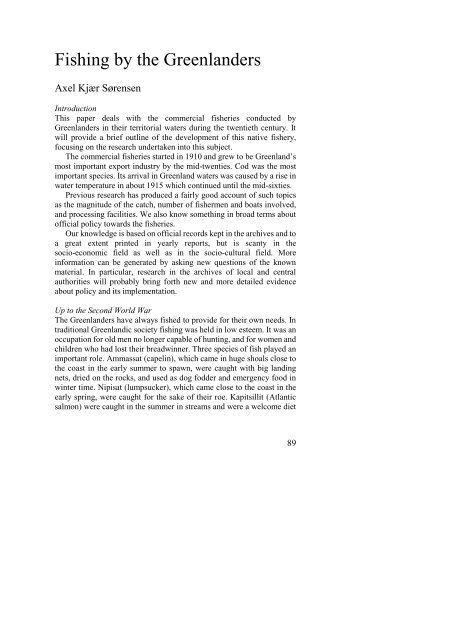The North Atlantic Fisheries, 1100-1976 - University of Hull
The North Atlantic Fisheries, 1100-1976 - University of Hull
The North Atlantic Fisheries, 1100-1976 - University of Hull
Create successful ePaper yourself
Turn your PDF publications into a flip-book with our unique Google optimized e-Paper software.
Fishing by the Greenlanders<br />
Axel Kjær Sørensen<br />
Introduction<br />
This paper deals with the commercial fisheries conducted by<br />
Greenlanders in their territorial waters during the twentieth century. It<br />
will provide a brief outline <strong>of</strong> the development <strong>of</strong> this native fishery,<br />
focusing on the research undertaken into this subject.<br />
<strong>The</strong> commercial fisheries started in 1910 and grew to be Greenland’s<br />
most important export industry by the mid-twenties. Cod was the most<br />
important species. Its arrival in Greenland waters was caused by a rise in<br />
water temperature in about 1915 which continued until the mid-sixties.<br />
Previous research has produced a fairly good account <strong>of</strong> such topics<br />
as the magnitude <strong>of</strong> the catch, number <strong>of</strong> fishermen and boats involved,<br />
and processing facilities. We also know something in broad terms about<br />
<strong>of</strong>ficial policy towards the fisheries.<br />
Our knowledge is based on <strong>of</strong>ficial records kept in the archives and to<br />
a great extent printed in yearly reports, but is scanty in the<br />
socio-economic field as well as in the socio-cultural field. More<br />
information can be generated by asking new questions <strong>of</strong> the known<br />
material. In particular, research in the archives <strong>of</strong> local and central<br />
authorities will probably bring forth new and more detailed evidence<br />
about policy and its implementation.<br />
Up to the Second World War<br />
<strong>The</strong> Greenlanders have always fished to provide for their own needs. In<br />
traditional Greenlandic society fishing was held in low esteem. It was an<br />
occupation for old men no longer capable <strong>of</strong> hunting, and for women and<br />
children who had lost their breadwinner. Three species <strong>of</strong> fish played an<br />
important role. Ammassat (capelin), which came in huge shoals close to<br />
the coast in the early summer to spawn, were caught with big landing<br />
nets, dried on the rocks, and used as dog fodder and emergency food in<br />
winter time. Nipisat (lumpsucker), which came close to the coast in the<br />
early spring, were caught for the sake <strong>of</strong> their roe. Kapitsillit (<strong>Atlantic</strong><br />
salmon) were caught in the summer in streams and were a welcome diet<br />
89















